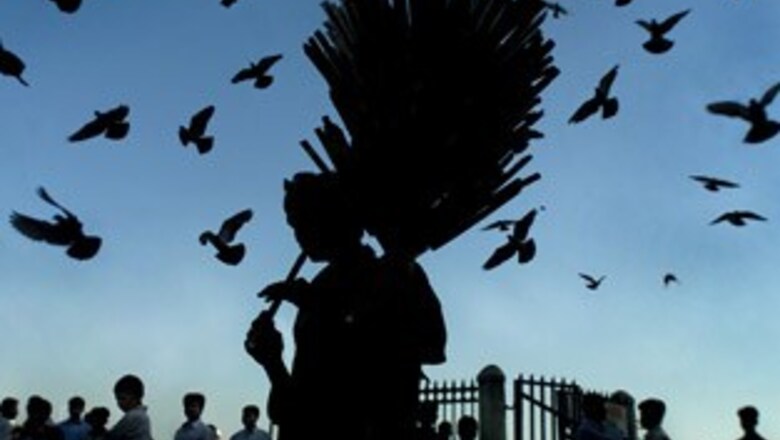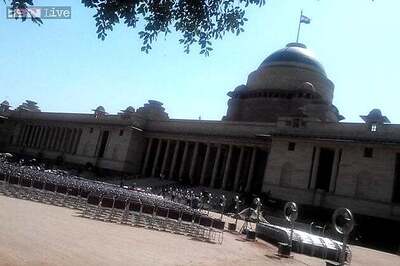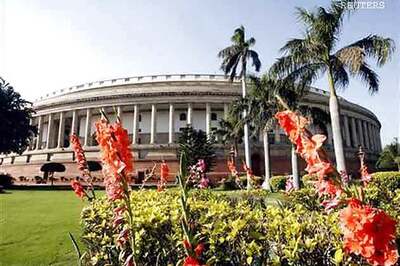
views
Dawn is still an hour away. Fog curls around the street lamps. The milkman’s bicycle jingle hasn’t been heard yet. The earliest risers are just stirring. Morning walkers, the women among them armoured in sarees, sneakers and mufflers, have yet to stride forth. Even stray dogs are fast asleep. A bird cheeps.
And then it begins.
A mild, prolonged Sa drifts out from a distant house where a rookie singer is known to be grappling with the notes. A prayer is heard somewhere. Women coming out to draw the traditional kolam patterns at their doorsteps chant Thiruppavai songs, dedicated to Lord Krishna. Elsewhere, a CD player fills the air with M S Subbulakshmi’s lilting voice.
Soon, throngs of people gush out from the street corners, singing with gay abandon. As their processions head for the temples, more people join them. The kolam ladies move on to pluck jasmine flowers, their lips move on to the next song. Temple bells come alive and sanctum sanctorums open, invoking more singing.
Radio and television stations begin the day with concerts of morning songs. Newspapers and magazines talk of music on their front pages. From bus stops to the arrival lounge at the airport, the buzz of music is heard everywhere.
It is the first day of Margazhi.
Margazhi, the Tamil month that begins in the middle of December, has unfailingly brought joy to the residents of Chennai each year. It not only brings relief from the punishing sun and the violent monsoon, but it also heralds the beginning of the Madras Music Season, a series of concerts, dance programmes and lecture-demonstrations around South Indian classical music, better known as Carnatic music. (And yes, as far as the Season goes, it is still ‘Madras,’ not ‘Chennai.’)
It is a form of music designed to stir the deepest wells of emotion in people. It is impossible to listen to Carnatic music and not feel humility in the smallness of man, wonder in the grandness of nature. It is a blend of devotion, musical grammar, rhythmic discipline and unpredictable experiences born from artistic improvisation. Its melody buries secrets that only years of learning can unravel, but it can captivate even the first-time listener. An introduction to Carnatic music is sure to rank among the most romantic moments in anybody’s life.
Chennai lives this romance throughout the year, but never as intensely as in December. When they say “Season” down there, they aren’t talking about the balminess of the weather but the flow of music in the month of Margazhi. But the irony remains that until a century ago, it had been the off-season for singing, both due to the unfriendly nip in the air and the religious tradition that forbade weddings during the month. Out-of-work singers began singing in temples in exchange for simple gifts, bringing music that was the exclusive preserve of the elite to the commoners. The trend caught on so well that associations of listeners, called “sabhas,” sprang up all over, establishing a tradition that is driven purely by private effort and with no government help.
The Season has now become the world’s largest musical event. As many as 40,000 listeners turn up to listen to 2,000 concerts by 400 musicians in eight languages, not to mention performances by 150 classical dancers and numerous lecture-demonstrations on music research. All in a matter of a few weeks.
And now, that time of the year is around the corner.
This year, the excitement is even more palpable, because of the surge of recognition that Carnatic music has been winning around the world. Concerts from Europe to Israel to Japan now attract not just the Indian diaspora but also the musically inclined among the locals. To a lesser extent, North Indians used to Hindustani music are becoming curious about this other form of Indian music. Research and experiments blending various forms of music with Carnatic are being carried out in universities around the world. And composers of film music are increasingly calling upon classical singers to render their tunes on celluloid.
“Carnatic music is at the beginning of a big golden era,” says T M Krishna, one of the most sought-after singers in this genre. “We are getting unprecedented opportunity and recognition.” Two factors have played a key role in the exponential rise in the following of Carnatic music over the last decade. While the average age of performers in many classical music forms has been going up, Carnatic has been attracting hordes of teenagers with concert-quality voices. “No other form of music has so completely been taken over by the younger generation,” Krishna asserts. (Only 33 years old, he is considered to be among the seniors.) There are many 20-year-olds and even 15-year-olds who are stepping into the professional circuit.
The second reason, ironically, is the march of technology.
A decade ago, many feared that the Season would lose its allure, that digital music systems and quick online downloads would kill it. But while the music industry around the world still grapples with the online invasion of traditional copyright models, Carnatic musicians have gone ahead and embraced the Internet and other technologies.
PAGE_BREAK
They have let a lot of their music be shared online, especially on YouTube. They conduct music classes, using Internet services such as Skype, for Indian students all over the world. Spot recording and webcasting of live concerts has begun. Listeners debate the nuances on social networking platforms such as Facebook and Twitter. And, as Carnatic music has spread through new media, it only ended up attracting new listeners.
The live concert form, exemplified by the Season, is not just intact but has become much more remunerative for the singers than it was before the 1990s.
“For most of our listeners, there is nothing like a live concert,” says S. Sowmya, a leading vocalist who discontinued her doctoral research programme in chemistry at Indian Institute of Technology, Madras, to pursue her music career. “They come for the ambience, action and audience participation.”
A cup of Kapi
“Sruti” and “laya” are the two most important words in Carnatic music, but one other word comes very close: “Academy.”
The Music Academy is the most powerful of the 100-plus sabhas that organise concerts during the Season. Only the very best are invited here. This is one reason why its concert tickets are always a sell-out. You are considered to have arrived in music only when you give a concert at the Academy, that too in the evening slot.
There are several other reasons. Mysore bonda and wheat halwa are a couple of them. The Academy--and other sabhas--also run excellent canteens that serve a mind-boggling variety of food. This combination of good music and good food has inevitably converted the Season into a going-out occasion for families and friends. The Academy starts receiving phone calls two or three hours before the main concert, not enquiring about the singer or the songs, but asking for the menu. Canteen franchisees often compare the patronage they get with the musician’s audience inside the hall. As the singers add exotic melodies to their repertoire, the canteens, too, have been adding their culinary counterparts such as keeravadai, kozhakkattai, Chettinad appam, paniyaram and sevai. Chaat, noodles and spring rolls made their debut at the Academy three years ago.
They tell the story of the legendary singer Madurai Somu, who held an overnight concert. As dawn approached, listeners began to leave. Somu stopped singing and told them “Ukkarungo, aduthadhu kapi dhan” (Sit down, Kapi is the next), punning on the name of a ragam he was going to sing and the Tamilian way of pronouncing coffee.
So, what is a ragam? Similar to Hindustani music, Carnatic follows a melodic system based on a solfege of seven primary notes (12 tonal positions including the flats and sharps). It does not have the harmony of chords, the pleasant coming together of different pitches. Ragam is similar to the Western concept of mode, but is different in some important ways. Think of it as a melodic base conforming to rules about which notes must be used in which order. With practice you can identify it in different songs set to the same ragam.
However, a ragam is much more than this. It gains life through a technique called gamakam, the shaking of a note to sound neighbouring microtones. So, a ragam does not progress as a discrete series of individual notes (like the equal temperament method in Western music), but in a gliding journey from one note to another. It can’t be notated and must be learnt by constant listening. And it must be learnt, ragam by ragam.
Experts have figured there are at least 34,848 ragas in Carnatic music, though only a few hundred are sung regularly. The ability to appreciate at least some ragams is a useful tool if you find yourself in Chennai in December.
Further, there is no absolute pitch in Carnatic music; each musician picks up the founding note and builds the song as a series of relative notes (experts call this just intonation).
But the key to enjoying a concert is not the knowledge of technicalities. It is quite easy to appreciate Carnatic music without an iota of knowledge of the ragam system. Just sit back and let the music flow to you (and don’t let the aroma from the canteen tempt you).
Pitching in
For those who already follow other forms of music, it is easy to make the crossover to Carnatic.
For jazz lovers, there are many songs that resemble the brass-band music of yore. Muthuswamy Dikshitar (1775-1835), one of the greatest composers of Carnatic music, wrote songs set to such tunes. He and his contemporaries had a keen interest in music from the Western world, thanks to the British Raj. Dikshitar even composed a song set to the tune of the British national anthem God Save the Queen (Santatam Pahimam, set to the scale of Shankarabharanam ragam).
For those who like the scatting in jazz, Carnatic offers Konnakol, the practice of using vocal cords as percussion, and the improvised rendering of the notes of a ragam by a singer who wants to display its various shades called manodharmam or kalpana swaram.
PAGE_BREAK
For lovers of Western classical music, there is a veritable treasure chest of Carnatic compositions. Dikshitar began the experiment two centuries ago and the tradition has continued to this day. An album by the Madras String Quartet--flowing Carnatic melodies on a stream of Western harmony--manages to blend the two systems tastefully. Film musician Ilayaraja has composed an oratorio of Thiruvachagam, a set of Tamil hymns to Lord Shiva written in the Ninth Century, which has been performed by the Budapest Symphony Orchestra.
Hindustani music fans must train their ears to a higher degree of gamakams in order to enjoy Carnatic. The shaking of the same note, say the second primary note Ri, could be done differently in two ragams. If you come with the Hindustani notion of a raag, you might find this disconcerting. Rest assured it is not besur (off key); it is just another shade of the ragam.
Beyond the bull run
In its energy and growth, the Carnatic music scene today resembles a bullish stock market. It has both good and bad players.
The variety and abundance of talent have led to a practice called kutcheri-nibbling, the jumping from one concert to another with an aim to cover many in a day. This leads to people walking out midway through a concert, especially during the solo performance of the percussionists. “Some in the audience also hum along, use their cell phones and generally behave badly,” says V. Ramnarayan, editor-in-chief of Sruti, a fine arts magazine.
Sowmya says walking out has almost become a tradition and she doesn’t allow it to distract her. There are calls for better audience behaviour now. Music lovers also lament the lack of recognition for instrumentalists. There are very few solo concerts of violin or flute; they used to be common once. The plight of percussionists is even worse. The money they get is a pittance, not just reward for their expertise.
Besides, there is a market only for the top 20 vocalists. Junior singers hardly get noticed. Many bring their own audience to the concerts. “Everybody is talented. What do you do?” asks Sowmya.
Time was when Carnatic musicians sang for the joy and little else. But in the last decade, it has become possible to pursue it as a career. In the next decade, the international audience will expand, making music a coveted profession. In all this rush, musicians are becoming serial singers and listeners trophy collectors. Neither has the time to stop and think.
Singers like Sowmya are worried about the concentration of so many concerts in such a short span. They say the Season could be spread over two months or half of it shifted to August, after the summer but before the monsoon rains. This way, singers as well as listeners could focus on the quality of musical experience and not on quantity. Some top singers are already cutting down the number of their concerts. But an overwhelming majority still remain committed to the month of Margazhi, saying the magic cannot be recreated in any other month.
The debate continues.
And that’s the beauty of the Madras Music Season. Nobody is in control. There are no rules. Anybody can force their way in. Or out. Diletanttes can rub shoulders with virtuosos; the discerning with the tone-deaf. Any experiment and every opinion is welcome. Nothing is ruled out.
And nobody shall go back hungry, either for music or food.
(For music and video links, and trivia about the Madras Music Season, go to business.in.com)




















Comments
0 comment